In this Crop Production and Management notes for Class 8, we will delve into the fascinating world of crop production and management. We will explore various aspects, from understanding the basics of agriculture to mastering the art of nurturing plants and maximizing yields.
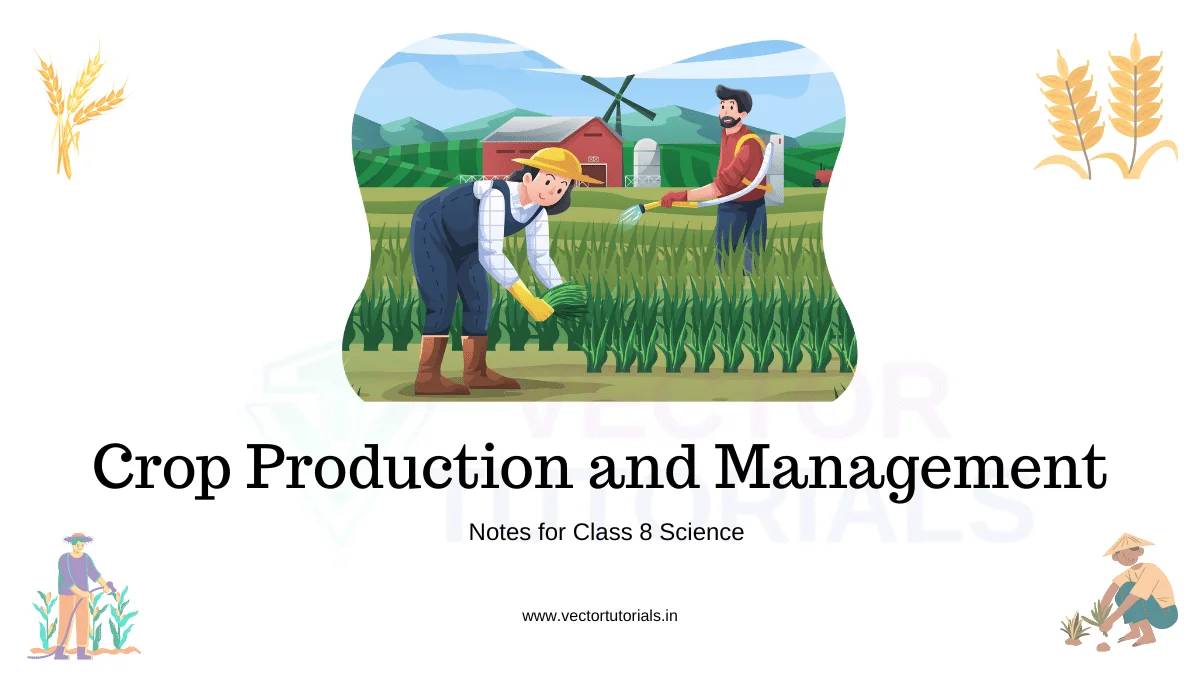
These notes have been meticulously crafted to cater to the needs of students. They are designed to be informative, engaging, and easy to comprehend. Whether you are studying for exams, seeking additional information, or simply exploring the world of agriculture, these crop production and management notes will prove to be an invaluable resource.
Crop Production and Management Notes
Welcome to the comprehensive guide on “Crop Production and Management” for Class 8 students. Agriculture, the backbone of our society, is pivotal in sustaining life on Earth. Understanding the science and techniques behind crop production is crucial for farmers and for everyone to appreciate the intricate processes involved in bringing food to our tables.
Throughout these crop production and management notes, we will examine essential topics such as the types of crops, methods of crop production, soil preparation, sowing and harvesting techniques, irrigation, fertilizers, etc.
You might want to check: 100+ Past Tense Examples with Hindi Translation
Crops
Plants grown by man on a large scale to obtain food, clothing, and other useful products are called crops.
Some examples of crops:
✓ Cereal crops: Wheat, paddy, maize
✓ Pulses: Gram, pea, bean
✓ Oil seeds: Mustard, groundnut, sunflower
✓ Vegetables: Tomato, cabbage, spinach
✓ Fruits: Banana, mango, guava
Types of Crops
| Based on Life Span | Based on Season of Cultivation | Based on Use |
|---|---|---|
| Annuals: These crops complete their life span in one year or one season. Examples: wheat, peas. | Kharif Crops: These are grown in rainy season. Examples: Rice, maize | Food Crops: These are grown to fulfill the basic food requirements. Examples: Cereals, pulses. |
| Biennials: These types of crops complete their life span in two year or two seasons. Examples: Carrot, Radish. | Rabi Crops: Such types of crops are grown in winter season. Examples: wheat, gram. | Cash Crops: Types of crops that are grown for commercial purpose. Examples: Tea, coffee. |
| Perennials: The crops are live for several years. Examples: Ginger, pine. |
Agriculture
Agriculture is the art and science of cultivating soil, producing crops, and rearing animals for food and other useful products.
- The early man collected the edible parts of the plants as food.
- However, when he observed that seeds give rise to new plants, he started farming and began to live a settled life.
- As time passed, he tried to improve the wild varieties of plants to meet his demands. Crop plants grown today have evolved due to this human activity over 2000 years ago.
Basic Practices of Crop Production
The crop production and management involves a series of steps that are followed in proper order. This includes preparation of soil, sowing, adding manure and fertilisers, irrigation, weed removal, harvesting, and storage of food grains.
We will discuss these steps for crop production and management in upcoming sections.

Preparation of Soil
This is the first step in crop production and management. The soil is prepared for sowing seeds of the crop by ploughing, harrowing, leveling, and adding manure.
Ploughing
- It is the process of breaking, loosening, and turning the soil over for uprooting weeds and aerating the soil.
- Benefits of ploughing
- Brings fresh nutrients to the surface.
- Loosens soil so that roots can penetrate easily.
- Soil can hold more moisture.
- Weeds are removed.
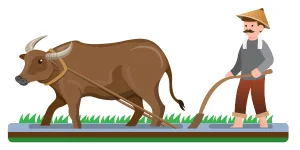
Implements Used For Ploughing
- Plough: It is a T-shaped instrument made of either wood or metal.
- One of the arms of the iron plough which is wedge-shaped, penetrates the soil.
- A plough is generally drawn by a pair of bullocks or horses. The plough is attached to the bullocks by using a yoke. The farmer controls the plough and guides the bullocks.
- Hoe: A hoe is used to remove weeds as well as loosen the soil.
- A strong, broad, and bent plate made of iron is fixed at one end of the hoe, which acts like a blade.
- The hoe is pulled by animals. You can see some hoe examples here.
- Cultivator: A cultivator is a tractor-driven agricultural implement used for ploughing.
- It has many ploughshares which can dig into a considerable area of soil and, at the same time, loosen it and turn it.
Harrowing
It is a method to destroy germinating weeds. It is done by using a blade harrow or spike tooth harrow in crop production and management.
Levelling
It involves breaking big lumps of soil and levelling it. Levelling is done by using a wooden or iron plank.
Advantages of levelling:
- Helps in uniform distribution of water during irrigation.
- It prevents topsoil from being carried away.
- Prevents loss of moisture.
Manuring
It is the process of adding manure to the soil. It is done to increase the fertility of the soil before the seeds are sown into it.
Sowing
The process of scattering seeds in the soil for growing crop plants is called sowing. Some precautions must be followed for sowing seeds.
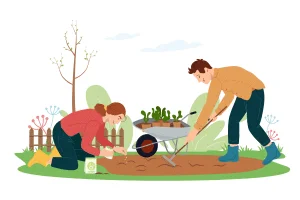
- Seeds should be sown at the right depth in the soil suitable for germination.
- Seeds should be sown at the right intervals or spacings in the field.
- Seeds should not be sown in dry soil.
- Seeds should not be sown in highly wet soil.
Methods of Sowing Seeds
1. Broadcasting: It is the process of manually scattering seeds in the field. This method results in the non-uniform distribution of seeds, affecting productivity.
2. Drilling: It is the process of sowing seeds at a uniform distance by using a seed drill. A seed drill is made of iron.
- Seeds are put into the funnel of the seed drill which is fitted at the back of the plough.
- As the plough moves, it cuts a hole into the soil, and the seeds move from the funnel into the hole, or a furrow is made into the soil.
Advantages of sowing with a seed drill.
- Seeds are sown at the correct depth and at the correct intervals.
- Seeds cannot be picked up and eaten by birds.
3. Transplantation: The process of transferring seedlings from the nursery to the main field by hand is called transplantation.
- Seeds are first allowed to germinate in a nursery to produce new varieties.
- When young seedlings are developed, they are planted in the field.
Advantages of transplantation
- It helps farmers to select better and healthy seedlings.
- Allows better penetration of roots in the soil.
- Promotes better development of roots and shoots.
- It enables farmers to plant seedlings at a uniform distance.
Adding Manure and Fertilisers
Plants require minerals for growth, and they continuously extract them from the soil. The deficiency of plant nutrients and organic matter in the soil is made up by adding manure and fertilisers to the soil.
Types of fertilisers
Fertilizers play a vital role in crop production and management by providing essential nutrients to plants, enhancing their growth, and maximizing yields. There are two main types of fertilizers commonly used in agriculture for crop production and management. These are Natural Fertilisers and Chemical Fertilisers.
1. Natural Fertilisers:
- Manure: Dead and decaying vegetable matter, waste from farms, household waste, and excreta of animals form manure. Manure mainly contains nitrogenous compounds.
- Compost: It is formed by the decomposition of vegetable and animal wastes. Organic substances are decomposed by bacteria and are converted into humus.
- Green Manure: Farmers grow leguminous plants such as groundnuts, soya beans, and pulses in between two crops. Leguminous plants help to replenish nitrogen in the soil.
Advantages and Disadvantages of Natural Fertilizers
| Advantages of Natural Fertilisers | Disadvantages of Natural Fertilisers |
|---|---|
| 1. Increase the water-holding capacity of the soil. | 1. Inconvenient to store and transport. |
| 2. Make the soil porous. | 2. Not nutrient-specific |
| 3. Improve soil texture. | |
| 4. Increase the number of useful microbes in the soil. |
2. Artificial/Chemical Fertilisers
They are used to fertilize a larger area at a time. They are made of ammonia, urea, and phosphates.
Advantages of artificial fertilisers
- Nutrient-specific and have plant nutrients in concentrated form
- Provide quick replenishment of plant nutrients in the soil.
- Highly soluble in water and easily absorbed by plants.
- Easy to store, transport, and handle.
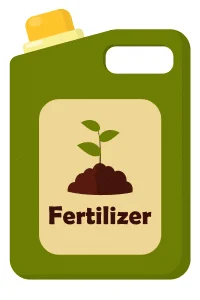
Disadvantages of chemical fertilisers
- Reduces fertility of the soil.
- Changes the chemical nature of the soil.
- It may cause water pollution through runoff.
Differences between Manures and Fertilisers
| Manure | Fertilisers |
|---|---|
| 1. Natural substance obtained owing to the decomposition of plant and animal remains by bacteria. | 1. Inorganic substances or compounds |
| 2. Less rich in plant nutrients. | 2. Rich in plant nutrients such as nitrogen, phosphorus and potassium. |
| 3. Can be prepared in fields | 3. Manufactured in factories. |
| 4. Inconvenient to store and transport. | 4. Easy to store and transport. |
Crop Rotation
Crop rotation is the practice of growing different crops each season in a particular field. For example, when a cereal crop such as maize is grown first, it takes away a lot of nitrogen from the soil for its growth and makes the soil nitrogen deficient.
Crop rotation is an essential technique for crop production and management. When leguminous crops such as pulses are grown in the same field, the crops with nitrogen-fixing bacteria enrich the soil with nitrogen compounds and increase its fertility.
Advantages of Crop Rotation
- Allows soil to recover its lost nutrients.
- It helps to control pests, weeds, and diseases.
- It also helps to reduce the use of chemical fertilisers.
- Improves fertility of the soil.
Organic Farming
Organic farming is a kind of farming in which crops are grown without using chemical fertilisers and pesticides. Food grown by organic farming is called organic food.
Irrigation
The process of supplying water to crop plants in fields through canals, wells, reservoirs, tube wells, etc., is known as irrigation. Wells, tube wells, ponds, lakes, dams, rivers, and canals are some of the sources of irrigation.
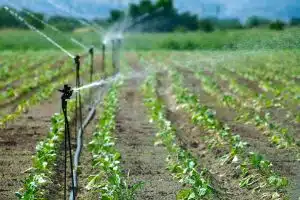
Need for irrigation in crop production and management
- To make the soil soft due to which ploughing of fields can become easier.
- To provide moisture for the germination of seeds.
- To maintain the moisture of soil for healthy crop growth.
Factors affecting Irrigation requirements of crops
The irrigation requirement of crops in crop production and management is affected by the following factors:
- Nature of crop
- Nature of soil
- Season
Methods of Irrigation
There are different types of methods of irrigation in India. These are classified into two sections, i.e., Traditional methods of irrigation and Modern methods of irrigation.
1. Tradition methods of irrigation in India
i. Canal irrigation: In India, irrigation of extensive areas is carried out by canals. The main canal receives water from different sources such as reservoirs or rivers and branches further for irrigation.
ii. Moat/Pulley System: The pulley system, along with a rope and a bucket, is known as a moat. Water is carried out from the well by using a bucket attached to a
rope that passes over the pulley. The rope is either pulled by man or by animals.
iii. Rahat System (Persian Wheel): A Persian wheel consists of a large wooden wheel with several buckets arranged on its outer rim. The whole arrangement is submerged in an open well.
iv. Swing Basket Method: The swing basket is an ancient water-lifting device. Two people stand facing each other and swing the basket to fill in the water. The basket is raised, and water is discharged into the crop field.
v. Dhekli: Dhekli is generally used to lift water from an unlined well, stream or pond.
vi. Chain Pump: The chain pump is used to lift water from a shallow well. It is useful to lift water from a depth of about 6 meters.
2. Modern methods of Irrigation
i. Drop Irrigation: Water is supplied through perforated pipes. Pipes are placed in rows between the plants close to the roots. It is used in fruit orchards, gardens, and trees.
ii. Sprinkle irrigation: Sprinklers or spray guns are attached to a large hosepipe at regular intervals to spray water. It is suitable for all types of crops.
iii. Basin irrigation: It is a kind of surface irrigation. The land is surrounded by embankments in the form of a basin. Basins are flooded with water. It is used for crops that require a large amount of water to grow.
iv. Furrow irrigation: Small channels or furrows are created along the field length between crop rows. It is used for crops that do not require much water.
Removal of Weeds
Wild and undesirable plants which grow in crop fields and compete with crops for space, soil, nutrients, water, and sunlight are called weeds. Amaranthus (Chaulai), Chenopodium (Bathua), wild oat (Javi), and grass are examples of weeds.
Disadvantages of Weeds:
- Compete with crops for available resources.
- It can be responsible for spreading diseases.
- Provide hideouts for rats and snakes.
Methods of Weeding
Weeding is the process of removal of weeds. This process is very important in crop production and management. It can be done by following methods:
- By Hand: Weeds can be removed from crop fields by pulling them out with hands.
- Using Implements: Weeds can be removed by digging or cutting them from close to the ground from time to time with implements such as a trowel, harrow, and hoe
- Spraying weedicides: A solution of weedicides such as 2,4-D, MCPA, and Butachlor is sprayed on the standing crops.
Harvesting
A combine harvester is used in commercial farming, where the processes of harvesting, threshing, and winnowing all occur in a sequence.
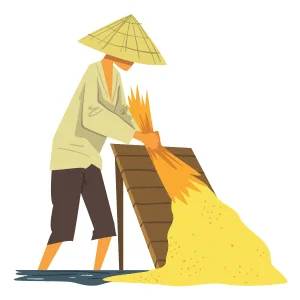
- Harvesting is the cutting and gathering of mature crops.
- Threshing is the process of beating grains from stems.
- Winnowing is the process of separating grains from the chaff.
- In India, the period of harvest is celebrated as a harvest festival.
- Pongal, Baisakhi, Holi, Nabanya, and Bihu are some of the harvest festivals celebrated in India.
Storage of Food Grains
The storing of food grains in crop production and management is crucial as the crop is ready, and without proper storage, it can be damaged. Harvested grains contain a lot of moisture. Hence, they are first dried. Harvested crops are stored until they are sold in the market.
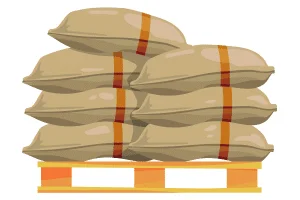
Methods of Storage of Food Grains
The food grains can be stored by the following methods.
| 1. Granaries | 2. Gunny Bags | 3. In Silos |
|---|---|---|
| Dried grains are stored in granaries. | Grains are also stored in gunny bags made of jute. | Government stores grains in large containers or tall cylindrical structures called silos. |
| Granaries are large metal or earthen pots. | The mouths of the bags are stitched tightly, and the bags are placed one above the other in big godowns. | Buffer stocks are stored in godowns to meet emergency needs in natural calamities etc. |
Food from Animals
| 1. Milk | 2. Meat and Eggs | 3. Honey | 4. Fish |
|---|---|---|---|
| Source animals: Cow, buffalo and goat. | Source animals: Goat, sheep, fish, hen and duck. | Source animal: Honeybee | Source animal: Fish |
| Milk and milk products are highly nutritious foods. | Rich in proteins | Highly nutritious food rich in proteins | Highly nutritious and easily digestible food |
Animal Husbandry
Animal husbandry is the branch of agriculture that deals with feeding, shelter, caring, and breeding of domesticated animals.
Important Practices of Animal Husbandry
- Proper feeding of animals
- Proper shelter of animals
- Prevention and cure of diseases in animals
- Proper breeding of animals
Crop Production and Management Notes FAQs
Here you will find important questions for Crop Production and Management. These questions are here to cover your basics and to give you and idea of what you’ve learnt so far.
That was all about the Crop Production and Management notes for Class 8 Science. We have included all the important topics and points to cover the basic concepts of Crop Production and Management. We recommend going through these notes for revision and practice questions accordingly.
More notes for Class 8 Science: